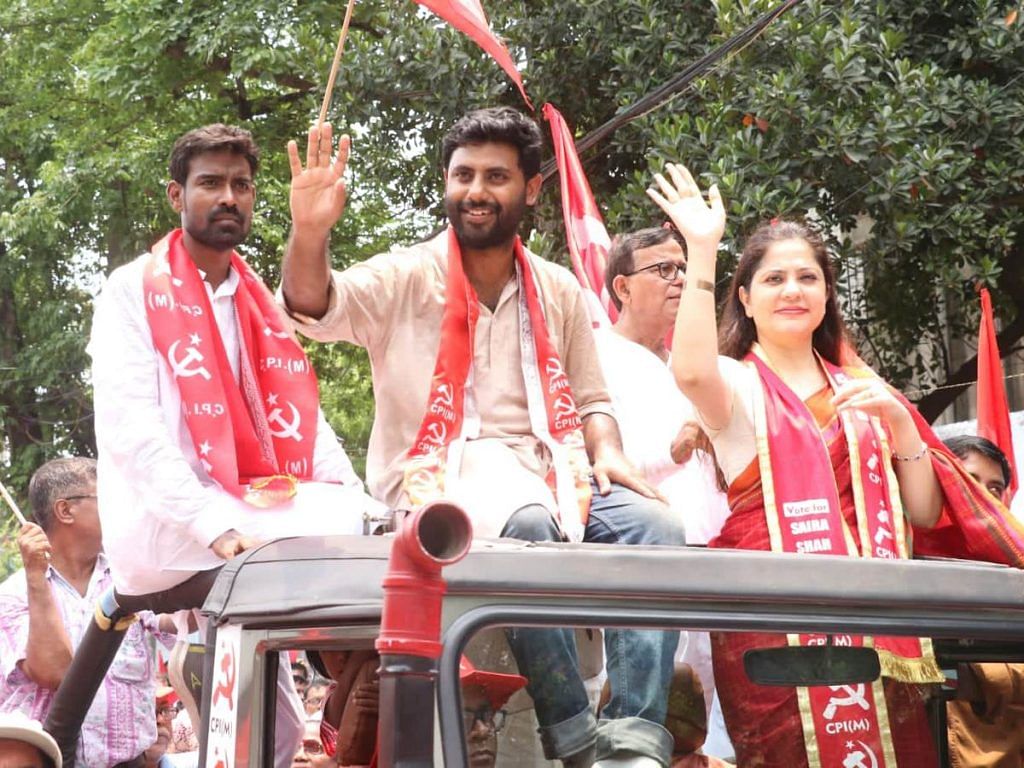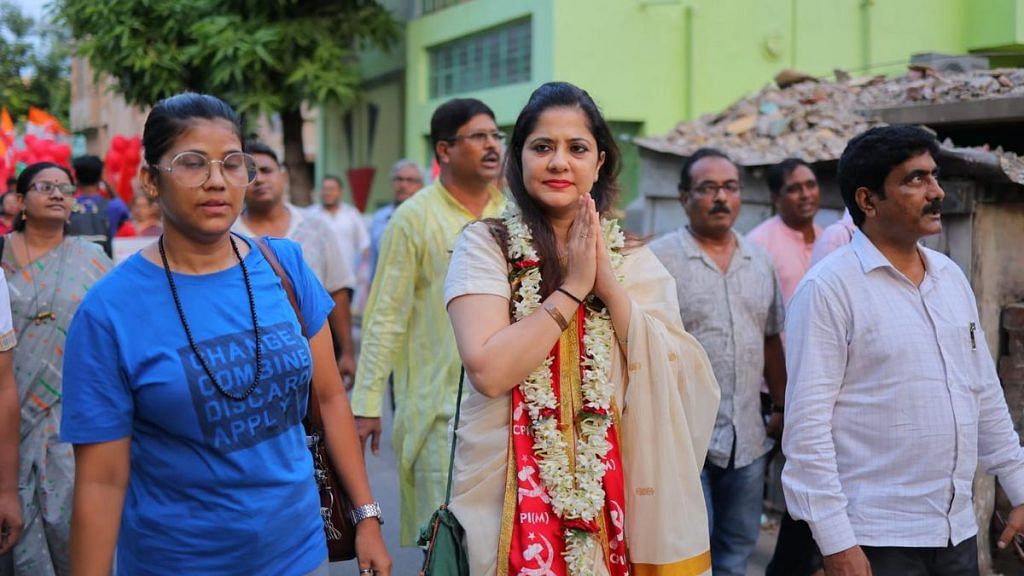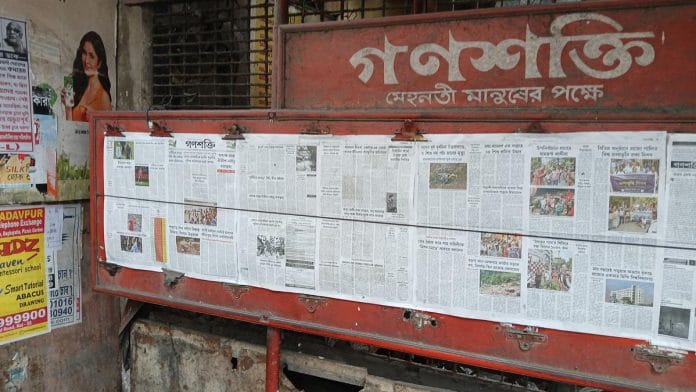Even after a hat-trick of zeroes by the Left parties in West Bengal, Surendranath Biswas, a 74-year-old retired public bank clerk and staunch Left voter, has not stopped visiting the narrow alley adjacent to the bustling Jadavpur bazaar in south Kolkata. Every day, the pages of Ganashakti, the Communist Party of India (Marxist)’s official mouthpiece, are displayed at a stand at the entrance of the alley, right beside a statue of Soviet leader Joseph Stalin.
This spot, behind the 8B bus stand, opposite Jadavpur University campus, is where Biswas and other Leftists meet every day to talk politics over raasta cha (roadside tea). Ever since the Left’s dismal performance in the 2024 Lok Sabha polls, the mood here has been gloomy.
“The Left parties in Bengal got zero seats in 2019, 2021, and now in 2024. What is there to read in their mouthpiece anymore?” Biswas told ThePrint. “I had thought the CPI (M) would get at least 3 seats this time from Bengal. And our Srijan (Bhattacharyya) would definitely be among the winners. Even Rahul Gandhi could revive the fortunes of the Congress, but our good girls and boys like Srijan, Dipsita (Dhar) and Sayan (Banerjee) could not bring the CPI(M) back.”
Srijan Bhattacharyya, 31, state secretary of the Students’ Federation of India and the CPI(M) candidate for the Jadavpur Lok Sabha constituency, understands the disillusionment of supporters like Biswas. With his smart one-liners and positive campaign messaging focusing on “people’s issues”, Bhattacharya became the crush of many young voters from Jadavpur University, and large crowds thronged to his rallies in the largely middle-class constituency. But on 4 June, results day, he finished third with 258,712 votes, trailing behind Trinamool Congress’ Saayoni Ghosh with 717,899 votes, and BJP’s Anirban Ganguly with 459,698 votes.
“There was huge support for some of us from the CPI(M) on social media and on the streets. But it was a bubble,” Bhattacharyya told ThePrint over the phone. “We need to go beyond our echo chambers now. The big crowd we saw at our Brigade Parade rally on 7 January did not translate into seats.”
Also Read: It’s time for BJP’s ‘ghar wapsi’ into RSS fold now—2024 LS election results are a signal
The gamble at Brigade Parade
The 7 January rally at the historic Brigade Parade Ground was a symbolic passing-of-the-baton-to the next-generation by the CPI(M), a party often criticised in West Bengal for failing to come out of the hangover of the Jyoti Basu-Buddhadeb Bhattacharjee-Anil Biswas-Biman Bose era. While Basu and Bhattacharjee ran Left Front governments for a combined 34 years in the state, Bose succeeded Biswas as the state secretary in charge of party affairs.
At the much-vaunted rally, another veteran leader and the current state secretary Md. Salim signalled a generational shift in the party.
“We are sowing the seeds to help them grow into plants… we will play the role of gardeners, provide fertilisers and irrigate the field well to help them grow,” he said to the cheering crowd.
Everyone took note of the crop of fresh faces at the rally. As journalist Swati Das pointed out, the CPI(M) had replaced its “weather-beaten and battle-scarred veterans” with young leaders who had made their name in student politics. This, she observed, seemed to be an attempt to shed the “historical baggage” of its “disastrous last few years in government, when the party alienated its own support base”.

Speaking at Brigade Ground, Srijan Bhattacharyya famously flipped Shah Rukh Khan’s dialogue from the 2023 hit Jawan.
“Baap ko haat lagane se pehle bete se baat karna parega (Talk to the son before laying a hand on the father),” he said.
It was not just that one smart line. It was the issues of roti, kapda and makaan that Bhattacharya and the other fresh faces in the poll fray emphasised during the campaign that gave many Left supporters hope that the CPI(M) wouldn’t come a cropper this time around.
True to their promises made at Brigade ground, the CPI(M) showcased a burst of young energy. Apart from Srijan Bhattacharya, there were Dipsita Dhar, 30, from Sreerampur constituency; Sayan Banerjee, 30, from Tamluk; Debraj Barman, 36, from Jalpaiguri; Nirab Khan, 43, from Bardhaman Purba; Saira Shah Halim, 46, from Kolkata Dakshin; Nilanjan Dasgupta, 50, from Bankura, and others.
All of them lost on 4 June, along with the older lot.
‘Communal binary’
In their internal analysis post-defeat, the CPI(M) concluded that the “communal binary” of the TMC and the BJP had divided the state sharply along religious lines, benefiting both while keeping the CPM (M) and other Left parties out of the game.
Kolkata Dakshin candidate Saira Shah Halim squarely blamed this “binary” for her loss.
“I had managed to break this binary during the 2022 Ballygunge Assembly polls and increase the Left’s vote share from 5 to 30 percent. This time I failed because the TMC and some local Muslim leaders branded me as a lesser Muslim,” Halim told ThePrint
An example of this, according to Halim, was that just before the first polling date on 19 April, the influential Urdu daily Akhbar-e-Mashriq ran a story claiming she spoke the language of Uttar Pradesh Chief Minister Yogi Adityanath. The paper referred to an old interview in which Halim had opposed loudspeakers in both mandirs and masjids.
“They made it look like I was speaking out against the Azaan. I was misquoted and wasn’t prepared for such communalism in Ballygunge (an assembly segment under Kolkata Dakshin), which is a mostly upper-middle-class area bang in the middle of the city,” she said.
The niece of actor Naseeruddin Shah and daughter of a retired army officer, Halim had banked on “progressive politics” in her campaign, focusing on roti, kapda, and makaan, and also targeting the TMC for various scams, such as the teacher recruitment case that sent former state education minister Partha Chatterjee and others to jail.

“My opponents ran a sexist and communal campaign with Bengali rights outfit Bangla Pokkho that tacitly supports the TMC,” Halim alleged. “They branded me an outsider, a ‘gutka-chewing Bihari’. I am not even from Bihar. My family comes from Uttar Pradesh, but I have spent more than 22 years in Kolkata. I am as Kolkatan as they come.”
Bhattacharyya also said that Bengal largely votes along religious lines now—something that was “unthinkable” even 10 years ago.
“West Bengal was a communally sensitive state after Partition and Bangladesh’s Liberation War. One of the Left Front government’s biggest achievements in the 34 years it ruled the state was to keep communalism aside,” he said.
Bhattacharya blamed TMC supremo and West Bengal Chief Minister Mamata Banerjee for making every Bengali voter acutely aware of their religious and caste identity.
“It is not just Hindu-Muslim. Even among Hindus, this entire controversy around Matuas came up during her reign. She has succeeded in creating binaries, which in turn create vote banks based on identity,” he said. “Because of her, the BJP-RSS has made deep inroads in the state. We have to create an alternative political narrative.”
Wrong target in Mamata?
For some Left-leaning voters, Bengal’s Communist parties have erred in targeting Mamata Banerjee instead of focusing on the BJP as their main ideological opponent.
For Sayandeb Chowdhury, who votes in Kolkata and teaches at the School of Interwoven Arts and Sciences at Krea University in Andhra Pradesh, this is major misstep. While he calls himself a Left Liberal, Chowdhury is quick to distance himself from the Bengal Communists for their “many historic blunders” since losing power in the state to Mamata Banerjee in 2011.
“Historically, the Left has risen against fascist forces across the world. In West Bengal, the Left devoted all their energy in attacking Banerjee, most whose social schemes align with the Left,” he said. “As a result, the BJP got the space to grow in West Bengal. And Mamata, on her part, fashioned herself as the only force that can stop the BJP in Bengal. The Left is left with no political space today.”
Chowdhury also disputes the notion that Bengal is entirely split along communal lines. He acknowledges some BJP-RSS penetration, but insists many voters primarily support Mamata “as she promises to keep the BJP away”.
Allying with the wrong partner was another of the Left’s “blunders”, according to Aroon Shah, vice-president of the Bharatiya Janata Yuva Morcha, the BJP’s youth wing. He pointed to the 2016 assembly polls when the Left and Congress formed an alliance.
This alliance, Shah claimed, benefited Congress while Left voters gravitated toward either the TMC or BJP.
“It was a Himalayan blunder on their part and the Left today is a vote cutter that ends up helping the TMC. They are a neither-here-nor-there party that does not even condemn TMC’s post-poll violence after winning elections,” he said.
Also Read: Bengal is ready for BJP’s Bhadralok Hindutva. Bhadralok Marxism is on its way out
Call for cue from Rahul Gandhi
Bad political decisions are not the only reason for the downfall of the Left, according to some long-term supporters. It’s also a failure of outreach.
Surendranath Biswas said Bengal has forgotten what the Left stands for.
“The CPI(M) released an AI-generated video of (the late) Buddhadeb Bhattacharjee seeking support for Left candidates before polls,” he marvelled. “What they need to do instead is walk the length and breadth of Bengal and remind people who they are, what they stand for.”
Chowdhury suggests the Left could take a cue from Congress leader Rahul Gandhi’s Bharat Jodo Yatra. This march across the nation reportedly helped Congress improve its tally of seats from 52 in the 2019 Lok Sabha elections to 99 in 2024.
“Gandhi managed to consolidate the political space from the Centre to the Left by walking the talk, connecting with people, using phrases like ‘mohabbat ki dukaan’ in a highly communal political atmosphere,” Chowdhury said. “The Left in Bengal should have a political language, forge new alliances with socially marginalised groups like Ambedkarites, and walk the talk by being visible to voters like Rahul Gandhi during his Bharat Jodo Yatra.”
It is not as if the Left did not walk. The 7 January Brigade Parade rally was the culmination of a 2,200-km walk by party cadres and supporters across Bengal as part of the youth wing’s Insaaf Yatra, which demanded jobs and education and protested against BJP’s communalism and TMC’s corruption. However, it didn’t get them seats in 2024.
For Srijan Bhattacharya, it’s a matter of increasing the step count through more such walks to get their message across the state.
“Bengal Jodo Yatra? Why not,” he said.
Deep Halder is an author and journalist. He tweets @deepscribble. Views are personal.
(Edited by Asavari Singh)







Bengal should follow textbook communism and sacrifice itself so that the rest of country excluding Kerala is constantly reminded about the horrors of communism.